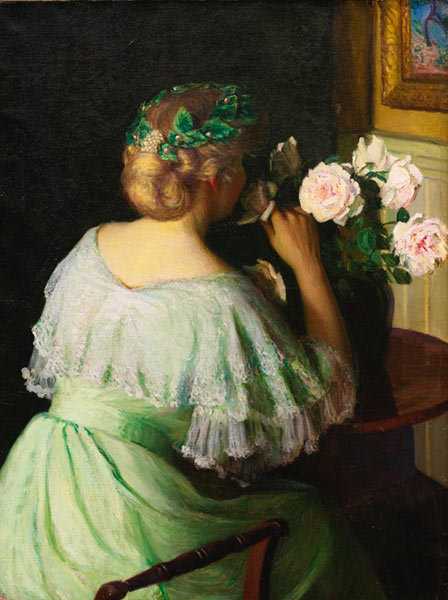In this ongoing series for Fine Art Today, we take a longer look at the history and features of a soon-to-be-available artwork of note. This week: Lilla Cabot Perry, “The Scent of Roses.”
Although she received little formal training and began her artistic career in her 30s, Lilla Cabot Perry (1848–1933) produced an impressive body of work that helped promote Impressionism in the United States and Japan. A privileged child of the Boston Brahmin Cabot family, Perry married Thomas Sergeant Perry — a distinguished literature professor at Harvard University — in 1874. The Perry home was undoubtedly an intellectual salon and it has been suggested that it was Perry’s brother-in-law, artist John La Farge, who urged her to pick up the brush. The rest, as they say, is history.
Perry first studied at the Cowles School of Art in Boston before traveling to Paris in 1887, where she attended the Académie Julian and Académie Colarossi. It was around this time that Perry first encountered the work of Claude Monet, a moment that would profoundly shape the rest of her career. Taken by Monet’s beautiful avant-garde works, Perry sought out the artist and cultivated a professional relationship. Through informal critiques and casual lessons, Monet helped shape Perry’s aesthetic vision, which she took home to Boston. At home, Perry published several essays on Impressionism and encouraged her friends and acquaintances to pursue collecting works by Parisians Monet, Renoir, and Degas.
In 1893, Perry and her family moved to Tokyo, Japan, where for nearly 10 years the artist painted over 80 pictures of Japanese scenes, drawing upon traditional techniques and designs that formulated the core of the Impressionist aesthetic. By the time of her death in 1933, Perry had established herself as an important figure within the modern art movement, not to mention amassing an impressive corpus of outstanding paintings, many of which are highly coveted and collected today.
Such is the case on October 2 at Sotheby’s, New York, when Perry’s “The Scent of Roses” heads to auction. Featuring within the “American Paintings, Drawings and Sculpture” sale, “The Scent of Roses” is an absolutely lovely picture, in which we find a seated female subject facing away from the viewer. Wearing a stunning green dress with flowing lace over her shoulders, the sitter leans her elbows on a small table while taking in the sweet aromas of a fresh bouquet of pink roses. The identity of the figure is unknown, her face draped in shadow, and the majority of the space itself has been significantly darkened, allowing the subject to radiate and separate from the picture plane. In the upper right corner of the piece, we find the slightest hint of another work adorning the wall, perhaps a Monet.
Perry’s brushwork within “The Scent of Roses” reveals her Impressionist sympathies. Albeit a calm and quite scene, the picture has a pulse of energy, most notably communicated through the sitter’s dress. Perry’s expressive and flowing strokes are readily detectible in the swaths of lime green, while the folds and subtle design in her lace creates a rhythmic dance across the center of the piece. The piece is sure to be a steal, with auction estimates set between $5,000 and $7,000. The painting currently resides in a private New York collection.
To view the full catalogue, visit Sotheby’s.
This article was featured in Fine Art Today, a weekly e-newsletter from Fine Art Connoisseur magazine. To start receiving Fine Art Today for free, click here.
Featured Lot: Lilla Cabot Perry, “The Scent of Roses”







